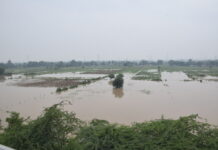[vc_row][vc_column][vc_column_text]
Nepal, the Himalayan nation which looks like a band-aid on India on the map, itself stands bruised and battered today in need of an immediate first-aid. As if the unsavoury developments of the past few months that saw deterioration in the bilateral ties between the two countries were not enough, shooting down of an Indian farmer by Nepal border police led to a new low in the hostility. Despite centuries of cultural and people-to-people relations, anti-India sentiments are building up in hitherto friendly neighborhood.
Of late, tempers in the cold Himalayan nation are soaring to such feverish pitch that even a friendly Prime Minister in Nepal is finding it difficult to toe a pro-India line. While there are many factors responsible for this turnaround, India’s big-brotherly attitude is paramount. This not only has led to general resentment but has almost pushed Nepal into China’s fold. A country which has open borders with India has today a border dispute with us.
It is not that India does not attach the importance that is due to Nepal, of course it does. But a lot more remains to be done on the bilateral front to mend fences with friend-turned-foe.
Prime Minister Narendra Modi visited Nepal four times in the last six years. But none of the visits seems to have made any qualitative difference between the two countries. In fact, things have come to such a pass that the once trusted neighbour has become our bête noir. If this is not the case why would it show Indian territories as its own? What prompted it to publish maps last year that included the Kalapani, Lipulekh and Limpiyadhura regions in Nepal?
Given the nature of Nepal it does not seem to have indulged in such a provocative act on its own. It either acted on the behest of China, or was motivated to do so to make India see its point of view. Whatever could be the reason behind the bravado, the provocation is such that no diplomatic effort is likely to restore normal relations in near future.
As a short-term implication of the strained relations many an Indian project in Nepal are stuck along with Indian investments affecting Nepal’s development. Nepal, on its part, banned the use of Indian currency in Rs 500 and 1000 Indian denominations in its territory. The schism between the Nepalese and Madheshis has only increased. The strained relations do no good to anybody.
Nepal, the friendliest neighbour has much in common with the mainland India. Predominantly Hindu population, cultural ties, and geopolitical location make it a natural ally. While both the countries are economically interdependent, dependence of Nepal on India is more. That is where the catch lies.
Nepal’s dependence on Indian investments for its mega projects is a case in point. Moreover, Nepal looks to India for many other things including healthcare, electricity etc. However, Nepal acts as a buffer against China. This is where Nepal has an edge; it leverages its ties with China to strike a balance.
China, on the other hand, needs friendly states in South Asia to sustain its influence in the region which explains its overtures to Nepal. Nepal has no qualms about flirting with the giant neighbour, but its authoritarian regime and its unconventional and at times brutal ways to deal with its own people makes the deeply religious country uncomfortable. Nepal is witness to what China did to Tibet, the treatment meted out to its own Muslim minorities in Xinjiang, Gansu, Ningxia, and Yunnan. All this is evident of Chinese indiscretion.
China has sent hundreds and thousands of its own citizens into detention camps. India, on other hand, is culturally so close to Nepal that any Indian visitor to that country would feel at home in that country.
To further complicate matters, the political situation in Nepal is anything but stable. Its five-year-old constitution is undergoing a litmus test as Prime Minister K P Oli chose to dissolve parliament. He was running the government with the support of his foe-turned-friend Prachanda.
Oli has always been pro-India, but now would do anything to maintain a safe distance from India in the wake of anti-India sentiments sweeping in the country for some time. If Oli carried a pro-India image, it’s well nigh impossible for him to maintain his constituency. The Left parties under the stewardship of Pushpa Kamal Dahal, better known as Prachand, have always been anti-India. In fact, their very base is anti-India bogey. So, Oli has no choice but to either fall in line or call it quits.
The Bone of Contention
So what is the basic issue that Nepal has with India? At the core of the Indo-Nepal crisis is ‘The Treaty of Peace and Friendship’ signed way back in the 1950s.
The treaty is loaded in favour of India. Nepal wants Articles 2, 6, and 7 of the treaty revised. It’s a long-standing demand of the Left Parties as well. But India neither revised the treaty nor addressed the concerns of Nepal. It has, in fact, made no attempt to amend the obsolete treaty even in the wake of changed geo-political scenario since it was signed.
Article 2 of the treaty states that both governments should “inform each other of any serious friction or misunderstanding with any neighboring state likely to cause any breach in the friendly relations subsisting between the two Governments”.
Articles 6 and 7 stipulate India and Nepal will give the same privileges of economic activity to each other’s nationals in their territory. It sounds fair, but in practice, it gives one partner the legal framework to meddle in another partner’s internal affairs, needless to say who benefits most from these provisions. It gives India a pretext to interfere in Nepal’s internal matters, especially foreign policy and defence.
Nepal has been frowned upon by India for establishing defence ties with China, its northern neighbour. The treaty was also questioned during former Indian PM Rajiv Gandhi’s era. At the time, even the monarchy wanted the treaty revised as it suspected the Congress government was clandestinely supporting the movement for democracy against the King.
Nepal always wanted equal treatment for its nationals. But India never bothered to address the demand of the ally. Moreover, the neighbouring country had issues with market access and transit facilities for trade. A few years back, a feeling was fanned in the country that India was domineering despite the Gujral Doctrine in place which gives an assurance to Nepal that New Delhi won’t interfere in its internal matters.
In August 1997, India and Nepal held a round of discussions to review the treaty without any worthwhile result. During his Kathmandu visit in 2014, PM Modi promised to look into the matter but to no avail.
Matters only worsened during the economic blockade witnessed between India and Nepal in 2015. The trigger was the agitation of Madheshis, the people of Nepal with Indian ancestry, against the country’s constitution promulgated that year which was attributed to New Delhi. The blockade hampered the movement of food and essential supplies from India to Nepal. The relations have been strained ever since
Nepali people want the treaty to be more relevant to the present times. There is a general feeling of discrimination against them. It is high time India addressed these issues. India’s relations with other neighbours aren’t as cordial as they ought to be. There are issues, though minor, need to be addressed for the all-around progress of the region. The South Asian Regional Cooperation (SAARC) is almost defunct today with nobody-gives-a-damn attitude responsible for its slow death. The SAARC could have been the biggest game-changer in the region’s development. It could have done to south Asia what ASEAN did to south-east Asian region
Nepal is reeling under political turmoil right now as it is heading for polls. It is vulnerable at the moment needing urgent diplomatic attention, and a reassurance from an old ally. India has done well by seizing an opportunity that came its way in the form of the Corona Vaccine and provided one million doses of Oxford-Astra Zeneca’s Covishield vaccine to Nepal as grant assistance.
The humanitarian gesture is bound to generate goodwill among the Nepalese. It may help build some good vibes but the effort needs to be backed up by other confidence-building measures. Right now, the vaccine diplomacy is working for India and it could well become a stepping stone for stronger ties. We certainly don’t want a hostile Nepal!
[/vc_column_text][/vc_column][/vc_row]
Disclaimer: We do undertake rigorous checks on content provided by contributors before publishing the same. If you come across some factual errors, kindly bring this into our notice and we shall review your objection and claim as per our policy and display correction credits and corrections on the article itself.
The opinion expressed in the article is of the writer. Writer is a freelance journalist/journalist based in Delhi





























